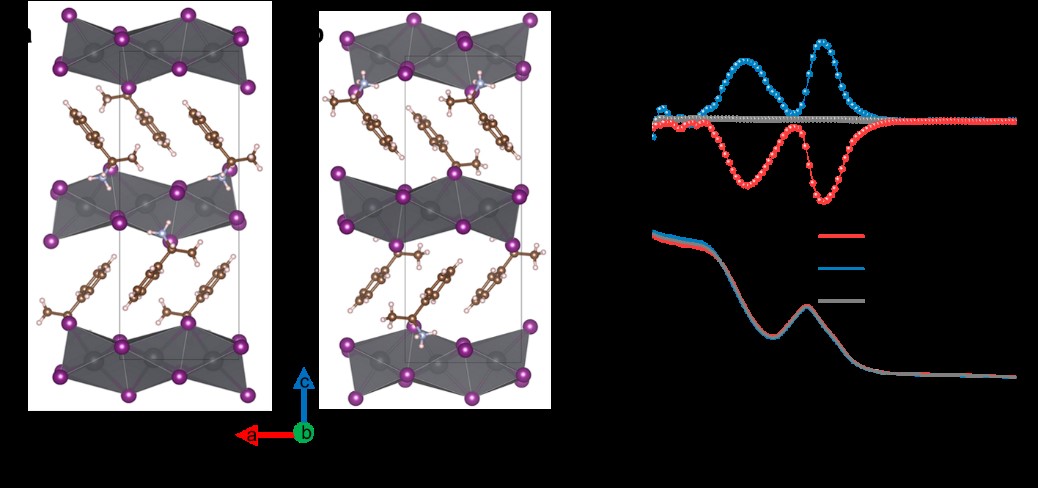On April 27th, Nature Communications published the research results of Prof. Jiang Tang in Wuhan National Laboratory for Optoelectronics on the chiral hybrid perovskite. The paper is entitled “Circularly polarized light detection using chiral hybrid perovskite”.
Circularly-polarized light (CPL) detection is required in various fields such as drug screening, security surveillance and quantum optics. Conventionally, CPL photodetector inevitably needs the installation of optical elements (such as polarizers, 1/4 quarter-wave plate, etc.), making it unsuitable for integrated and flexible devices. The established CPL detectors without optical elements rely on chiral organic semiconductor (Nat. Photonics, 2013, 7, 634) and metal metamaterials (Nat. Commun., 2015, 6, 8379) for direct CPL detection, but they suffer from extremely low responsivity (< 10 mA W-1) due to the fundamentally poor charge collection efficiency. In general, chiral organic materials tend to exhibit strong circular dichroism due to the presence of chiral sites or chiral helical structures. Inorganic materials have good charge transport properties, but they are difficult to have chirality. The combination of organic materials with strong circular dichroism and inorganic materials with high charge transfer to construct organic-inorganic hybrid semiconductors is an ideal solution for strong chiral discrimination and highly sensitive CPL detection. The organic-inorganic hybrid perovskite represented by CH3NH3PbI3 is successfully used in solar cells, photodetectors, and light-emitting diodes due to its outstanding photoelectric performance, high defect tolerance and low preparation cost. However, CH3NH3PbI3 is achiral, so CPL detection cannot be achieved.

Fig. 1. The structures of (a) (R-α-PEA)PbI3 and (b) (S-α-PEA)PbI3; (c) The CD spectra and normalized absorbance.
The researchers chose chiral (R)-α-methylbenzylamine (R-α-PEA) and its enantiomer (S)-α-methylbenzylamine (S-α-PEA) as the A site, lead (Pb) and iodine (I) as the B and X sites, respectively. (R-α-PEA)PbI3 and (S-α-PEA)PbI3 single crystals were prepared by the inverse temperature crystallization method. The crystal structure was determined by single crystal diffraction and powder X-ray diffraction characterization as orthorhombic P212121 chiral space group (Fig. 1a, b). The PbI6 octahedrons were connected into inorganic frameworks as the face-sharing type. Then (R-α-PEA)PbI3 and (S-α-PEA)PbI3 single crystals were dissolved in N,N-dimethylformamide (DMF) to prepare precursor solution. The perovskite films were deposited on quartz substrates by spin-coating and annealing processes. Circular dichroism measurement indicated that the films exhibited a pronounced signal at 328 nm and 392 nm (Fig. 1c). As shown in Fig. 1c, (R-α-PEA)PbI3 has a higher absorption capacity for the right-handed CPL absorption than the left-hand CPL, and (S-α-PEA)PbI3 has a higher absorption capacity for the left-hand CPL than the right-hand CPL. According to the different absorption capacity of chiral perovskite to left-hand and right-hand CPL, CPL detection is realized.

Fig. 2. (a) Schematic diagram of our photodetector; (b) The responsivity under CPL; (c) Light intensity dependent LDR and responsivity.
The researchers prepared (R-α-PEA)PbI3 and (S-α-PEA)PbI3 perovskite films into photoconductive detectors (Fig. 2a) and tested their responsivity under left-hand and right-hand CPL, respectively. It was found that under the excitation at 395 nm light, the detector has the ability to distinguish between left-hand and right-handed CPL (Fig. 2b). The discrimination of the detector for the left and right-handed CPL (gres) is defined as 2(RL-RR)/(RL+RR), where RL and RR are the responsivity of left-hand and right-hand CPL, respectively. It can be seen from Fig. 2b that the gres of the chiral perovskite CPL detector is about 0.1. Through the light intensity dependent photo responsibility measurement, the researchers found that the responsibility of the detector could reach 797 mA W-1 under weak light intensity. Further tests have shown that the noise is less than 10-25 A2 Hz-1 and the 3dB is 150 Hz. Through the noise and responsibility, the calculated detectivity reaches to 7.1×1011 Jones. In addition, the researchers fabricated flexible devices on PET substrates as the same process, achieving the comparable performance to that of rigid substrates. Finally, the researchers also studied the storage stability of perovskites in the environment and found that they were stored in the environment for one month without showing significant performance degradation.
The research work was completed by the group of Prof. Jiang Tang in Wuhan National Laboratory for Optoelectronics. This work was supported by the National Key R&D Program of China (2016YFB0700702) and the National Natural Science Foundation of China (61725401 and 5171101030). Chen chao, the postdoctoral fellow of Wuhan National Laboratory for Optoelectronics in Huazhong University of Science and Technology, was the first author, and Prof. Jiang Tang was the corresponding author.
Paper Link: https://www.nature.com/articles/s41467-019-09942-z